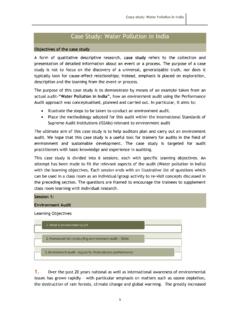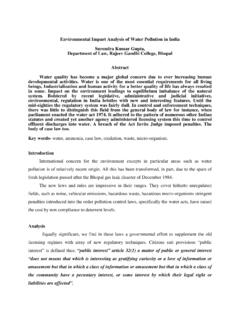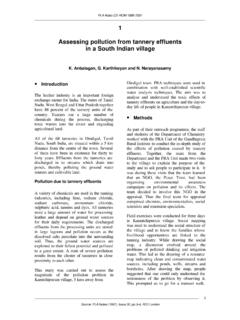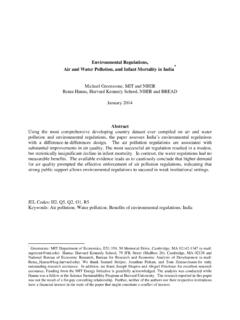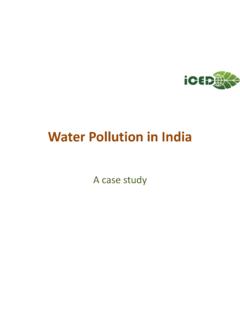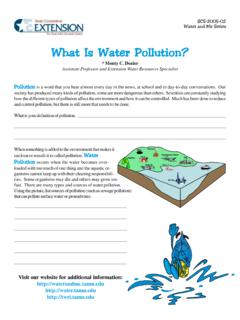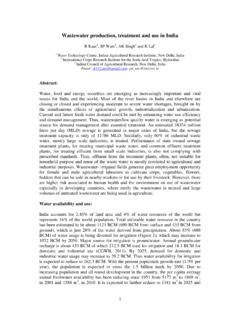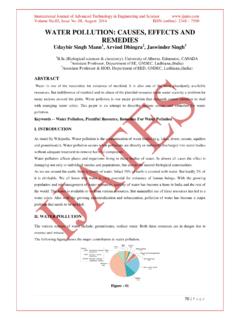Transcription of WATER POLLUTION BY INDUSTRIES: CAUSES AND …
1 NO V E M B E R 2 0 1 6 | I S S N : 2 3 9 4- 5 0 4 4 TH E WO R L D JO U R N A L ON JU R I S T I C PO L I T Y 1 | THE WORLD JOURNAL ON JURISTIC POLITY 2016. ALL RIGHTS RESERVED. | WATER POLLUTION BY INDUSTRIES: CAUSES AND CONSEQUENCES Dr. S. Manjula The Tamil Nadu Dr. Ambedkar Law University, Chennai Industrial civilization has led to the tremendous growth of industries including the hazardous ones. WATER is one of the most important industrial materials required in the manufacturing process, and so, many industries are established around the WATER bodies. The use and discharge of hazardous substances have contaminated air, WATER , and soil, rendering the environment more and more unfit for healthy living within and outside the industrial establishment.
2 These industries pollute the WATER resources by discharging toxic effluents causing health hazards to living beings. According to Dome Barbara Ward, the former President of the International Institute for Environment and Development, London observed that WATER is everywhere the key to human comfort, health and even survival. Hence, this paper is an attempt to highlight the growing industrial WATER POLLUTION in spite of laws and enforcement machineries. Keywords: WATER , POLLUTION , Industries, Hazards, Health. Introduction You can live without oil and you can even live without love, but you cannot live without water1 . WATER is one of the most precious natural resources of the earth, without which the living beings cannot survive.
3 WATER is important for the sustenance of human civilization. Earth is estimated to have 1400 million cubic kilometers of WATER of which is salt WATER in the oceans and is fresh WATER . Of the fresh WATER that is available a major portion of it (75%) is frozen in the Polar Regions. Of the remaining 25% of fresh WATER , groundwater constitutes 23% and surface WATER forms a meager 2%2. The WATER resources are not uniformly distributed over the world. It is therefore not surprising that WATER disputes assume local, inter-state and international dimensions. In the Indian sub-continent, these disputes centre round the Indus, Ganga and Brahmaputra rivers at the international level involving india , Pakistan, Bangladesh and Nepal.
4 At the inter-state level the sharing of the Godavari, Krishna and Cauvery waters in the Indian Peninsula has been a burning problem involving the riparian states of Maharashtra, Andhra Pradesh, Tamil Nadu, Kerala and Karnataka. 1 The importance and the seriousness of the WATER crisis was stressed by the former US Ambassador to india Mr. Daniel Moynihan by these words. 2 , Scarcity of groundwater for irrigation: Economics of mechanisms in hard rock areas (Bangalore: University of Agricultural Sciences, 1998), NO V E M B E R 2 0 1 6 | I S S N : 2 3 9 4- 5 0 4 4 TH E WO R L D JO U R N A L ON JU R I S T I C PO L I T Y 2 | THE WORLD JOURNAL ON JURISTIC POLITY 2016.
5 ALL RIGHTS RESERVED. | POLLUTION of WATER Resources Until a few decades ago WATER POLLUTION used to be primarily a local problem with identifiable sources of POLLUTION . Most of the wastes came from human and animal excreta and other biogenic compounds. Many of these problems could be controlled by treatment plants and alternative technologies. However, over the years the increasing gross POLLUTION load of the receiving waters and its complex character have resulted in a situation which calls for radical change in our approach to save this precious resource. The growing scale of cultural and technological development poses new threats to WATER quality. One major threat to WATER comes from the production of a growing number of chemicals.
6 These industrial chemicals, reach the receiving waters indirectly via households, agricultural activities, drainage, atmosphere and industrial chemical channels. In addition, huge quantities of industrial waste containing these chemicals and other toxic materials are deposited in landfills. Some of these substances are not biodegradable and progressively accumulate in the aquatic ecosystems, through leeching and seepage. Industrial CAUSES or Sources In india , the industrial units are installed mainly on the basis of availability of raw materials, access to market, transport facilities and other techno-economic considerations. No proper attention is paid to the environmental aspects while setting up an industry in an area.
7 Political and economic policies of the Government have also influenced the decisions in this regard with emphasis on raising productivity to serve the population. This increased productivity in turn, has given birth to more industrial hazardous wastes, thereby adversely affecting the environmental balance through the wasteful use of natural resources. Industrial development has also led to POLLUTION of WATER . The Centre for Science and Environment, New Delhi in its Report, says that 70% of all available WATER in india is polluted and about 73 million workdays are lost due to WATER related diseases3. WATER is one of the most important industrial materials required in the manufacturing process, and so many industries are established around the WATER bodies.
8 The major source of WATER POLLUTION is the waste WATER discharged from industries into WATER bodies. Industrial WATER POLLUTION amounts to several times that of domestic waste WATER and continues to increase every day. The toxicity caused by hazardous industries is a matter of grave concern. According to an Expert Committee on Ganga Action plan, the total volumetric domestic POLLUTION is 75% and industrial POLLUTION is 25%, yet in toxic terms the industrial POLLUTION is much more. The industrial wastes include chromium, mercury and other toxic substances, which may explain that, despite the lesser percentage of POLLUTION by industry, the deadly effects these highly toxic substances are greater. These industries pollute the WATER resources by discharging toxic effluents causing health hazards to living beings.
9 3 The State of india s Environment 1982: A Citizen s Report 16 (1982) NO V E M B E R 2 0 1 6 | I S S N : 2 3 9 4- 5 0 4 4 TH E WO R L D JO U R N A L ON JU R I S T I C PO L I T Y 3 | THE WORLD JOURNAL ON JURISTIC POLITY 2016. ALL RIGHTS RESERVED. | Hazardous Substances and Health Hazards POLLUTION marks the presence of the ambient environment of chemical, physical and biological factors capable of inducing disturbances in the normal physiology and functioning of human organs. Accordingly, the issues of health and hazardous substances have a direct correlation in producing undesirable effects. It may be noted that the use of chemicals will inevitably grow with industrialization and this poses an increasing risk to human health and environment.
10 The use of chemicals will inevitably has grown in the production and preservation of products of daily use. Many items be the milk, tomato sauce, paints, detergents, cosmetics, manufactured drugs or various forms of plastics when polluted, contaminated or adulterated, pose threats to human health. So extensive is the use of chemicals today that some environmentalists have described this trend as the growing chemicalisation of our lifestyle . It is also surprising that deadly properties of some of the hazardous substances are little known to us. Allergies as well as damage to vital organs of human body, such as the eyes, brain, liver, kidneys and reproductive organs; malformations of unborn children and genetic disorders are attributed to these substances.

